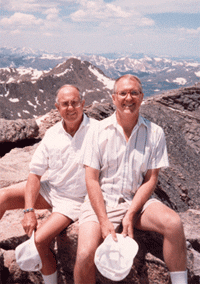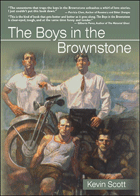
 This is the first time The Independent Gay Writer has run
two reviews of the same book simultaneously and on the same page. Tony
Heyes from England and Jerry Flack from the U.S. go head to head on the
book, The Boys in
the Brownstone. Both reviewers are long-term contributors to
IGW, and each brings his unique perspective to these reviews.
This is the first time The Independent Gay Writer has run
two reviews of the same book simultaneously and on the same page. Tony
Heyes from England and Jerry Flack from the U.S. go head to head on the
book, The Boys in
the Brownstone. Both reviewers are long-term contributors to
IGW, and each brings his unique perspective to these reviews.If you enjoy this kind of presentation, please let the editor know. And please let Tony and Jerry know what you think, as well.
  Tony Heyes' review... Tony Heyes' review...The Boys in the Brownstone by Kevin Scott Harrington Park Press 2005 ISBN 13: 978-1-56023-295-7 ISBN 10: 1-56023-295-1 Kevin Scott embarked on a difficult task in writing The Boys in the Brownstone. This was to write a novel that encompassed the lives of several individuals whose lives intersect at “The Brownstone”, a gay club. To deal with so many people within the covers of a book of average length requires a certain amount of backfilling. Mr. Scott shows himself to be skilled in encapsulating those aspects of his characters’ histories necessary to our understanding of their place in the scheme of things. The kaleidoscopic nature of their relationships forms the backbone of the story’s plot. The tale opens with a few individuals who are thrown together on “the night before the night before Christmas”, taking refuge at the club during a snow storm. The first character we meet is Roberto, a South American business man whose wife has just left him, taking their two children with her, after he has told her he is gay. Tired of living a life of pretence, he made his fateful decision after finding himself lusting after Wesley, the odd job man, an aspiring gardener whom he met at the home of a couple of married friends in Maine whilst staying with them. Unfortunately for Roberto, Wesley is involved with Mike, a Catholic priest he met in an internet chat room. Mike dotes on Wesley and has spent all his money, and much of his parish's, on him. He is contemplating embezzling parish funds to set Wesley up in the business he craves but is having a crisis of conscience over it. He is also having a crisis of conscience about the relationship. How it is “resolved” takes the reader by surprise. Frank, the curator of a TV museum, is suffering from a different crisis, a crisis of confidence. All his life he has lived in the shadow of his dazzling brother, Perry. He feels his work is second-rate and his relationship with his boyfriend, Emmett, is heading for the rocks. Salvation arrives in the form of his brother who, it transpires, has always envied Frank’s freedom to be himself and not conform to his parents' impossibly high expectations. Perry has left his wife and thrown up his job. Perry helps him through his crisis, undergoes a Damascene revelation about the nature of his own life, publishes a book he has agonised over and achieves liberation. Ian, a soap opera script writer is in thrall to two men who seem to think more of humanity than of individuals, Bobby, his political activist boyfriend and his own father, the Reverend Trevor Reath, a Presbyterian minister. Ian and Bobby are getting married and Reath senior has sacrificed his job, unbidden, to perform the ceremony. Ian is losing control of his life. Unbeknown to him Bobby occasionally “fools around”. Bobby tells himself it means nothing. He is happy to jog along with Ian— they get on so well. Ian wants proper commitment and in the end finds it in the arms of his oldest friend, Nathan. The most engaging story is that of Neil, a young man waging a vendetta to get the killer of his lover. Believing that revenge is sweet, he succeeds beyond his wildest imaginings, only to discover that there are few things sadder than answered prayers. Fortunately, he picks himself up and attains a sort of peace. This brief account does not exhaust the full list of characters. Like Jane Austen’s Emma, The Boys in the Brownstone is a slow burn book. During the first few pages one wonders if it is going to go anywhere, then suddenly one is hooked. What happens to each of the characters suddenly matters. Mr. Scott is pleasingly adept at relating his characters to each other and recounting their histories as well as their stories in a way that does not lose the reader in what is, potentially, a narrative maze. Throughout, the events unfold lucidly and satisfyingly. He is also skilled in his use of shifting viewpoints; sometimes the story is recounted by the narrator, sometimes in the first person by one of the characters. All in all, this is an engaging read. Each of the mini-tales contains enough material for a full-blown novel and it would be nice to think that at some future date Mr. Scott will see fit to tell us more about each of his dramatis personae. |
 Jerry Flack's review... The Boys in the Brownstone by Kevin Scott Harrington Park Press 2005 ISBN 13: 978-1-56023-295-7 ISBN 10: 1-56023-295-1 “It was the night before the night before Christmas….” (p.1) If Kevin Scott’s opening words in his first novel sounds familiar listen to the lines Clement Moore spoke to his ailing daughter on another late and very snowy December evening in New York City in 1822, not 2004. “Twas the night before Christmas…” begins the most famous secular holiday narrative poem ever written, but the similarity between the writers and the tales end there. In 1822, Moore was a religious scholar and professor at New York City’s General Theological Center. He shared his story “A Visit from St. Nicholas” with his family and in 1823 his niece saw that it was first published in a Troy, New York newspaper. The rest, of course, is history. In 2005, Steve Scott is a screenwriter, playwright, and critic and he shares with a far larger audience his first novel, The Boys in the Brownstone. Scott’s novel is hailed by many as a fine new novel and much of the book cover publicity and buzz about Scott’s initial novel is that it is, to quote critics, “a hilarious comedy of manners.” Scott’s work may well be such, but this reviewer is really not sure what a “comedy of manners” is supposed to be and perhaps should bow out as a critic of the work at this point. However, if it s a novel about a group of upper middle-class gay men, most of whom are not fully out of the closet, drink way too much, and treat each other with virtually no fidelity or honor, then he begins to comprehend what a “comedy of manners” is. Perhaps the best way this writer can best approach a review of The Boys in the Brownstone is by returning to his days as a public school English and literature teacher. All middle and high school students were supposed to be instructed that the rudimentary literary elements of a novel were the sum of these parts: plot, setting, characterization, voice, and theme. To begin with there is really no central plot that binds the many characters and actions in the novel. It begins promisingly enough with a story of Roberto, a wealthy Brazilian businessman who on the very first page places his now hysterical wife and two children on a plane headed back home to Sao Paolo, Brazil so that he can cease lying and begin to live an open New York gay life that he presumes will be “exhilarating.” He has found his way, despite an immense snow storm, from Roosevelt Island to the “staid-looking” Brownstone mansion that serves as a pretentious gay bar in Manhattan and also serves as the primary setting for the multiple plots that unfold in Scott’s novel. Unfortunately, for both Roberto and readers, all too soon another plot line emerges as his life crosses paths with Wesley, a handsome young plumber, gardener, opportunist, and breaker of hearts from the tiny island of Stonehaven off the coast of Maine. Next, the story of Wesley in a different relationship with “Father Mike” who is the assistant pastor of a Catholic parish and crazy in love with Wesley evolves. While many of the stories are at least reasonably interesting, they all become a blur after a time. They also have a pronounced tendency to be about and most likely appeal to wealthy gay men, affluent-wannabees, and hangers-on in the New York City upper crust gay milieu The first problem for this reader of The Boys in the Brownstone is that no sustained plot exists. To be sure, there are plenty of gay issues that surface in the novel such as gay marriages, fidelity and commitment to one’s lover or partner, parental disapproval, and AIDS and its concomitant assisted suicides. However, on the whole, Scott’s first novel appears to be far more a collection of slightly interconnected short stories than a full-fledged novel. The setting is the Brownstown, a “gentleman’s bar” (read wealthy gay men and opportunists) in the fashionable and wealthy Upper East Side of New York City’s Manhattan where gay men come to drown their sorrows, meet up with fresh meat, and renew former acquaintances, even in one case, with the dead. The Brownstone may be THE classy New York City watering hole with a long and distinguished reputation and the people who frequent it may well represent some of the crème de le crème of Big Apple gay night life, but for many other readers the Brownstown seems not merely unfamiliar but unappealing, and even worse, a trifle. A “crude” mid-westerner visiting the city for the first time may well wish to ask, “Why on earth would I want to go there?” The biggest downfall of Scott’s novel is characterization. First, even some of the best-written characters such as Wesley and “Father Mike” seem more like stereotypes or stock characters for whom readers may well lack empathy. How many novels feature an in-the-closet gay priest? Certainly, a great many. The second problem is Scott simply has put too many characters into his first novel who not only seem remarkably alike but are far too numerous. One needs a score card to keep track of mostly uninspired characters. Thankfully, there are some exceptions. The novel truly comes to life in a chapter aptly, but sadly, titled “Farewell, My Lover.” (Indeed, from this reviewers’ perspective, this chapter would have made a better novel than the one that exists. It comes with a tragic but terrifically engrossing plot, rich characters, more diverse settings, great dialogue, and a terrific theme that commingles the subjects of infidelity, love, and forgiveness, family alienations, homophobia, and most importantly, revenge and its costs. In a matter of just hours, an art and antique gallery owner, Neil Moore, who is a thoroughly nice guy and a highly upstanding NYC citizen and businessman, loses his lover and business partner of a decade or more to a vicious homophobic assailant and hospital negligence, plus learns simultaneously that his now dead lover, Bucky (Roebuck), had betrayed him by having sex with their best friend. To lose one’s lover to homophobic violence is tragic. To discover on the same evening that the lover has been unfaithful not only adds greatly to the enormity of Neil Moore’s life-and-death tragedy, but is enough to sufficiently push him over the edge and alter him from a mild-mannered Clark Kent-style gallery owner into a gay Superman of grudges. Through a chance encounter while on an errand of mercy and charity, Neil and his sister meet on this same snowy evening a drifter who witnessed the attack that resulted in Bucky’s death and he gives Neil the information he needs to positively identify Bucky’s killer. Of course, the thug’s wife has provided the killer with an alibi and New York’s “Finest” are not going to lose any sleep over the veracity of the wife’s excuses for one more killer of just another gay Jewish man. Neil’s “crazed” pursuit of justice and of the ill-named killer, “Angel,” is the stuff of dreams fulfilled, terrific cinema, and righteousness penned into great novels. “Farewell, My Lover” truly ignites the novel as no other chapter does. Bucky’s senseless death (and his discovered betrayal) transforms Neil. He cooperates with the police, but realizes that they are not going to do much to find his gay lover’s killer. Neil truly becomes ingenious as he pursues Bucky’s killer with a grudge and vengeance that brings the novel fully alive. Perhaps it may appear homophobic to say so, but one of the reasons the chapter “Farewell, My Lover” is such a fine piece of writing is that the characters seem to be made of real flesh and blood and to come from all walks of life. This is not just another story of gay men of privilege hanging out exclusively. Here is a chapter that involves both gay and straight people whose grief seems palpable, who are devoted friends and relatives that genuinely care about the unnecessary death of a good man, and most definitely the single-track mind of revenge Neil feverishly, but ingeniously pursues. These characters “feel” like a true assortment of real New Yorkers who are not citizens fashioned from Genre, Architectural Digest, and Instinct. They are made of flesh and blood; they cry, worry, and even take clever and inventive revenge. Although the circumstantial elements, particularly plot and setting, are very different, Scott’s chapter, “Farewell, My Lover” resonates with readers in a manner similar to Tim Ashley’s brilliant novel, The Island of Mending Hearts (London: Gay Men’s Press, 2004). Ashley peopled his novel with a great many characters, too, both living and dead; perhaps as many as Scott introduces in The Boys in the Brownstone, but the enormous difference between the two novels—excepting Scott’s chapter, “Farewell, My Lover”—is that the Key West characters of Ashley’s beautiful and deeply moving novel that involves many of the same themes as Brownstone come alive as real people readers truly care about and want to root for regardless of whether they are gay or straight. The difference is something that is truly from the heart. Readers fall in love with (or even come to loathe) Ashley’s characters and genuinely care about the joys or vicissitudes of life as it hits them. Give Scott credit. He is a fine writer. His prose itself is a pleasure to read and he handles both first-person narratives and dialogue (even between the living and the dead) with panache. What he has yet to master is using all his writing talent to tell stories that truly make readers experience the rush of feeling that they can hardly bear to wait to turn to the next page and that they never want to reach the final page. Yes, there a few too many boys and too many stories being exchanged at the Brownstone, but Kevin Scott’s novel is worth a read and, perhaps considerably more importantly, raises hope that a better structured and more empathic novel will be his follow up work. |